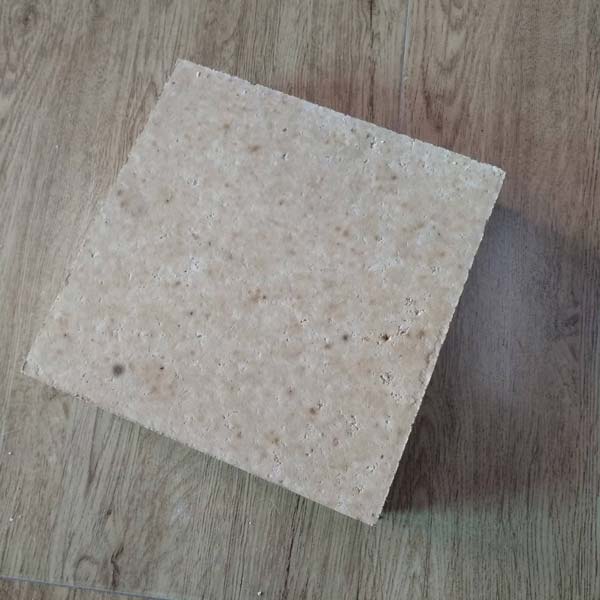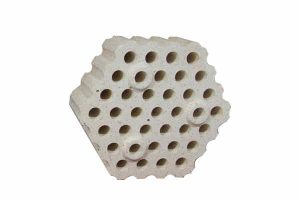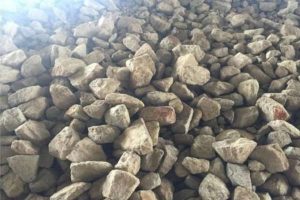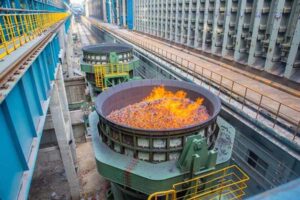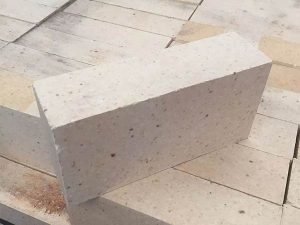Material and Characteristics of The Distinction
Low creep clay brick with bauxite clinker as the main raw material, uzupełnione specjalnymi dodatkami, poprzez formowanie pod wysokim ciśnieniem, i wypalanie w wysokiej temperaturze, has the advantages of large heat storage capacity, small creep rate, itp.
It is suitable for the supporting hot blast furnace of the small, medium, and large blast furnaces, and is mainly used in the lower and middle walls of heat storage, lower lattice bricks, supporting strings, i inne części.
Low creep clay brick with coke stone, red pillar stone, electrofusion mullite as the main raw material, and add a few additives. Using the three-stage batching, co-grinding fine powder, i inne procesy, developed a porosity of 1 3 ~ 1 5 %, creep rate of 0 5 ~ 0 8%, 0 2Mpa load softening temperature of 1 4 72 ℃, room temperature compressive strength of 1 0 0MPa hot blast furnace clay brick, the clay brick has good high-temperature volume stability, creep and wear resistance.
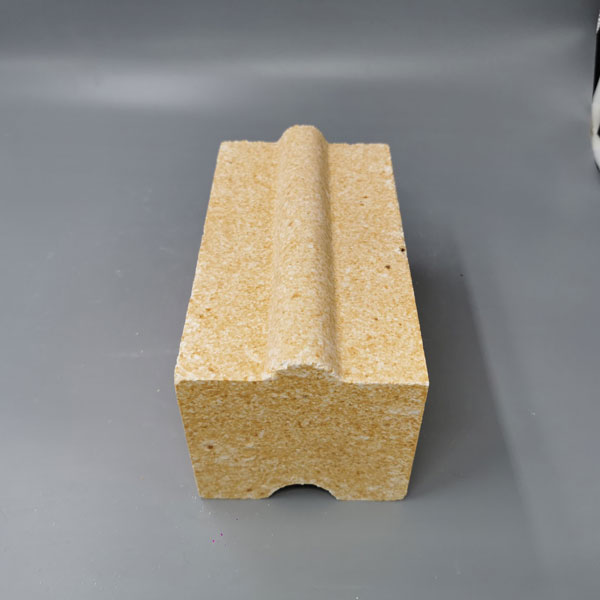
Low creep high alumina brick raw materials are II high alumina clinker (water absorption 4%), high purity silica, AL2O3 content greater than 99% of white corundum, and pure Suzhou clay. Low creep high alumina brick creep rate test method at present, the domestic creep rate test method, the calculation method is not uniform.
Commonly used methods are a 50h creep rate of less than 1% I 20%.
50h creep rate of less than 0.2% two kinds.
1. In 0.2MPa pressure, 1550 ℃, 50h cremdashep rate of less than 1% (high product). In 0.2MPa pressure, 1450 ℃, 50h creep rate of less than 1% (medium). At 0.2MPa pressure, 1350℃, 50h creep rate is less than 1% (low product).
2. At 0.2MPa pressure, 1550℃, 50h creep rate less than 0.2% (high grade). In 0. 2MPa pressure, 1450 ℃, 50h creep rate less than 0.2% (medium product), in 0.2MPa pressure, 1350 ℃, 50h creep rate less than 0.2% (low product); 0.2% is the difference between 50h and 20h creep rate less than 0.2%.
Now mostly use 50h creep rate less than 0.2%, to evaluate the low creep high alumina brick resistance to high temperature creep performance.
Low creep clay brick and low creep high alumina brick how distinguished?
The aluminum content, weight, and density of the two are not the same, the use temperature is not the same, and the price is also different.
What is the effect of low creep refractory bricks on the high-temperature performance of refractory materials?
Al2O3-SiO2 ma dobrą odporność na pełzanie, o czym decyduje mikrostruktura materiału (tj., względna zawartość fazy krystalicznej i szklanej w materiale, stan podziału pomiędzy fazami krystalicznymi, and crystalline and glass phases).
Low creep brick type according to the microstructure characteristics, refractory brick factory will be low creep refractory brick into the following three basic types.
1. Code M mullite type refractory aggregate part (containing coarse particles and fine particles) is composed entirely of mullite. Mullite crystals are long columnar and needle-like, which constitute a special interlocking shelf structure with gaps filled by mullite; the matrix is distributed with fine in situ generated primary mullite and secondary generated mullite or certain additions.
2. Code M-C mullite-corundum type resistant material aggregate part (containing coarse or fine grains) is mullite, korund. Interlocking columnar, needle-like mullite, the interstices of which are filled by corundum or mullite, the matrix part is in situ generated mullite or secondary mullite, sub-micro corundum or certain additives.
3. Corundum-mullite type corundum has short columnar, barrel-shaped crystals, which are not interspersed or interlaced in the structure of the resistant material. Between corundum crystals embedded with mullite interlaced columnar crystals, effectively prevent the corundum crystal slip, to obtain a stable structure.
The above types of low creep brick because the crystal structure is more stable, more conducive to the excellent performance of mullite or mullite and corundum, such as melting point: mulit 1870 ℃, korund 2050 ℃, the two co-fusion temperature is higher, 1840 ℃, which is conducive to the improvement and improvement of the high-temperature performance of the material.
4. Types of low creep brick, crystalline phase content (mullite or mullite + korund) as the main body, play a leading role, the glass phase content is the second, and the glass effect has little impact. Impurities on the impact of low creep refractory brick in the Al2O3-SiO2 system, impurities are mainly Fe2O3, TiO2, R2O, RO, itp.
What is red pillar brick?
In the industry standard (YB4032-91) and the Dutch type red pillar brick, there are clear requirements for the chemical composition. Ogólnie mówiąc, impurities in raw materials are closely related to the glass phase content.
Glass phase content increases with the impurity content, we hope that the impurity content is less, the corresponding glass phase content is also less, so that in the microstructure of the resistant material, the glass phase into isolated distribution, not wetting the crystalline phase, for the weak glass phase effect (tj., at the grain boundary for the grain and grain combination, good creep resistance).
On the contrary, impurities more glass phase content is high, it is bound to wet the crystal phase in the structure of the high degree when the glass phase completely wet the crystal phase, the glass phase to form a continuous phase structure, will affect the creep rate, easy to produce larger creep at lower temperatures.
In the study of high TiO2 rhodochrosite, a preliminary conclusion has been reached: high TiO2 rhodochrosite concentrate from a certain place can be used.
Our research is on a high TiO2 rodochrozyt concentrate as the main or auxiliary materials, according to the high alumina brick production process, when high TiO2 rhodochrosite in the right amount, the right particle size, with other raw materials, can be made of creep temperature at 1400 ℃, creep rate of 0.2% of the product.
The choice of raw materials and particle size, itp.
1. Raw materials Al2O3-SiO2 system materials, mulit, and corundum are important raw materials, and there are many varieties of raw materials, take mullite as an example.
How to choose raw materials?
Based on: 1. The characteristics of each raw material. 2. Suitable price.
Ogólnie mówiąc, electrofused mullite is better developed than sintered mullite, and the skeleton formed by interlocking mullite crystals is relatively strong. Fewer grain boundaries, reduce the slip of grain boundaries, which is conducive to creep resistance. So when making low creep bricks, electrofused mullite. Sintered mullite of each brand, alumina-based mullite quality is better than the corresponding bauxite-based mullite.
Compared with the corresponding brand of bauxite mullite, the former has more mullite content and better crystal development.
The quality of mullite obtained from the wet process is better than that of the corresponding brand of mullite from the semi-dry process because the material is fully homogenized. The choice of three stones, in the stereotyped products, is more choice of silica plus red pillar composite raw materials.
2. Particle size in the development of new products, should pay attention to the particle size distribution. Particle size distribution is different, affecting the performance of the product. The traditional coarse, medium and fine three-stage ingredients are no longer suitable. Nanotechnology has been applied to science and technology, life today, the refractory material ingredients should be selected multi-grade, as far as possible in line with the principle of close stacking, to obtain a dense body. The minimum requirements of the grading are coarse, medium, fine, and micro-fine 4 levels. W tym samym czasie, the particle size of raw materials should be continuous, each particle size range is covered, as far as possible in line with the principle of compact stacking.
3. Temperature calcination temperature selection, so that the matrix and aggregate combined closely is very important. Three stone brick still has several characteristics to be further explored and utilized (such as thermal shock resistance, resistance to CO, electrical insulation, itp.).
Refractory material cracking, peeling, easy to wear how to do?
PER refractory is engaged in the production and R&D of refractory materials for many years and can solve all kinds of difficult problems of high-temperature kiln lining, and welcome new and old friends to consult and exchange technology.

